|
|
#1
|
|||
|
|||
|
I am trying to find out from anyone on here if the original printing plates from baseball cards pre 1960 have ever been found or made available to purchase at auction. The reason I am asking is I found at the Chicago National about 10 years ago a curved zinc printing plate that had 8 small cards? baseball player images on them from 1932-36 era They were similiar to the 1934 (R310) butterfinger issue, with signatures, but small, like 1/2 the size of a T206.
I am very curious if ANY pre war card printing plates have EVER been found?? Please reply  MORE PICS SEE BELOW REPLY MORE PICS SEE BELOW REPLY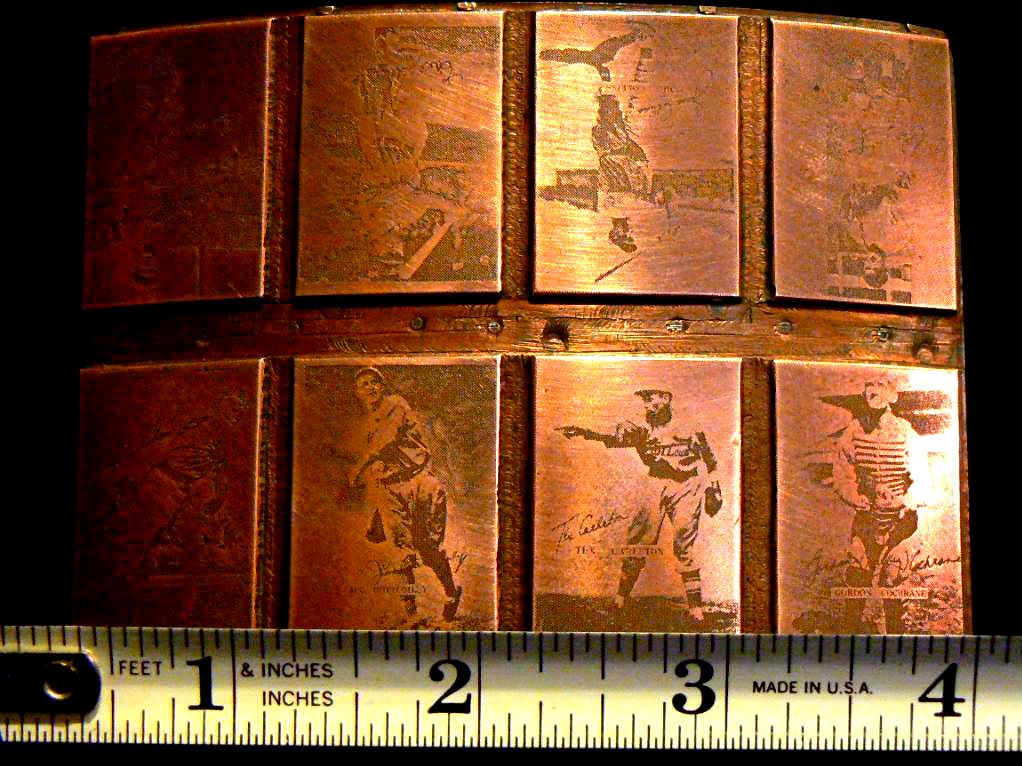
__________________
"Variety is the Spice of Life!" Last edited by olsport; 01-24-2010 at 03:35 AM. Reason: new info see below |
|
#2
|
|||
|
|||
|
Not baseball, but a lithographer's stone was found for a circa 1910 hockey tobacco card set. You should be able to find a picture and more information by searching the Net54 Vintage Hockey forum. I would love to see a picture of what you have!
Yours in collecting, Alan Elefson aelefson@hotmail.com |
|
#3
|
|||
|
|||
|
Paul - sounds interesting. Are the poses the same as the Butterfinger issue or were you just using that as an example of the style? There were many issues that have an image of the player with a facsimile signature on them; perhaps if you look here, you might find a match:
http://www.oldcardboard.com/ |
|
#4
|
||||
|
||||
|
I have had this printing block of a baseball player for awhile and am not sure were to find out about it. Can any of you help with it as long as you are on this subject? It has I.P.B. in a triangle in a rectangle on the end with 402 stamp into the wood next to it. Any idea of year? Thanks D.
Last edited by D. Broughman; 09-19-2013 at 07:17 AM. |
|
#5
|
||||
|
||||
 
|
|
#6
|
||||
|
||||
|
Years ago in SCD there was an article about some aluminum printing plates for sheets of 1954 Bowman baseball being found used to hold up insulation in an attice in SE Pennsylvania. I don't recall how may plates were found.
__________________
My (usually) vintage baseball/football card blog: http://boblemke.blogspot.com Link to my custom cards gallery: http://tinyurl.com/customcards |
|
#7
|
||||
|
||||
|
Wow I do remember that article! I remember thinking that would be so cool to remove wallboard and find printing plates behind it!!
|
|
#8
|
|||
|
|||
|
OK-here are the detailed pics & info. of my Baseball Card Printing Plate. It is 8 cards on a copper coated curved zinc plate. Each card measures a very small 1 5/8" length by 7/8" width. They are similiar to R306s and or R310s. The players are as follows: Gordon Cochrane, Tex Carlton, Jim Bottomley, George Earnshaw, Paul Waner, James Collins, Earl Averill, and Paul Derringer. This means the plate is from somewhere between 1932 to 1936. What tiny cards came out from then? Each is a print from a photo with facsimle signature and name below that in all CAPITOL letters.
 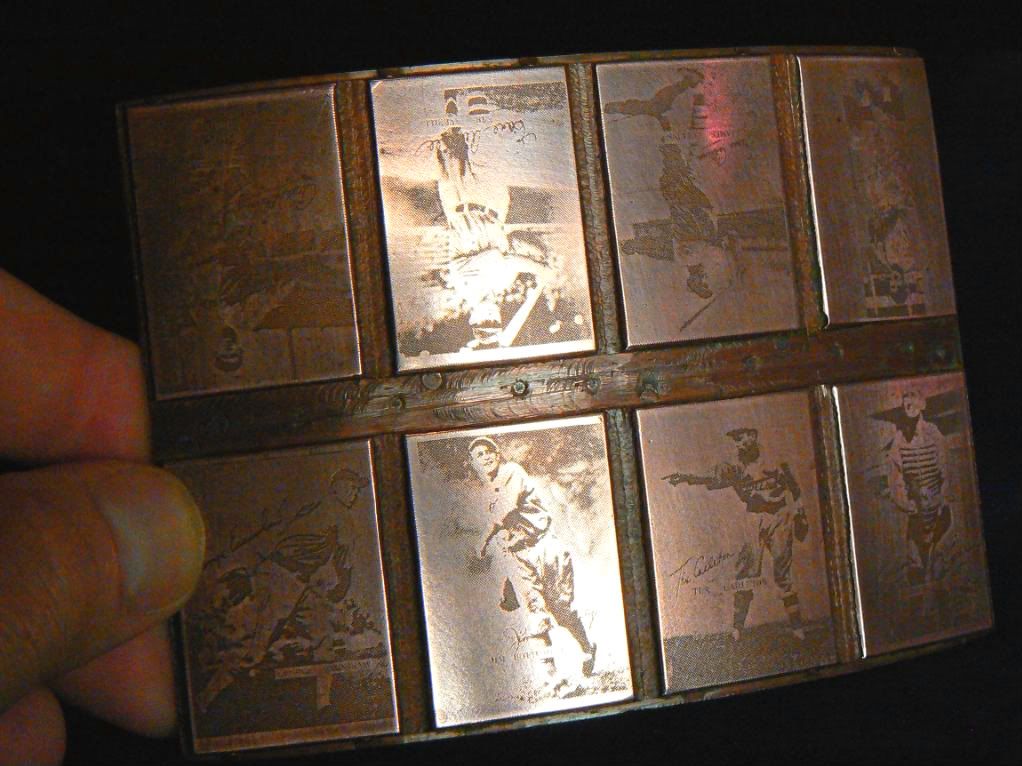 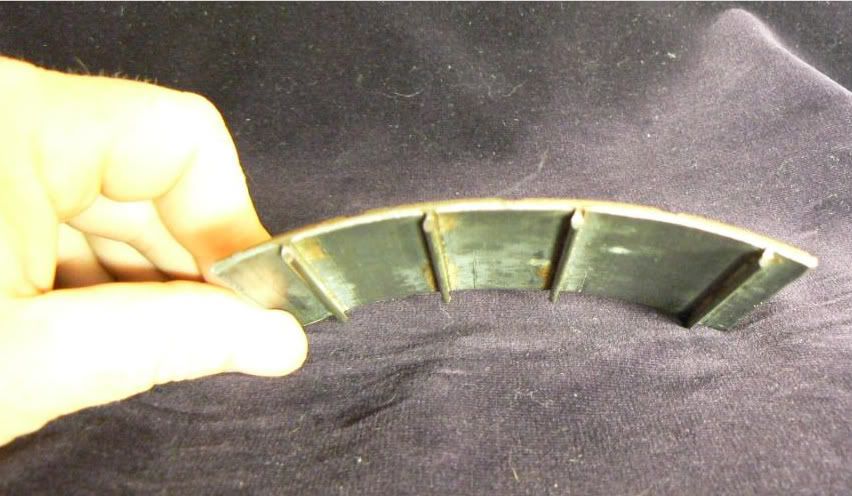 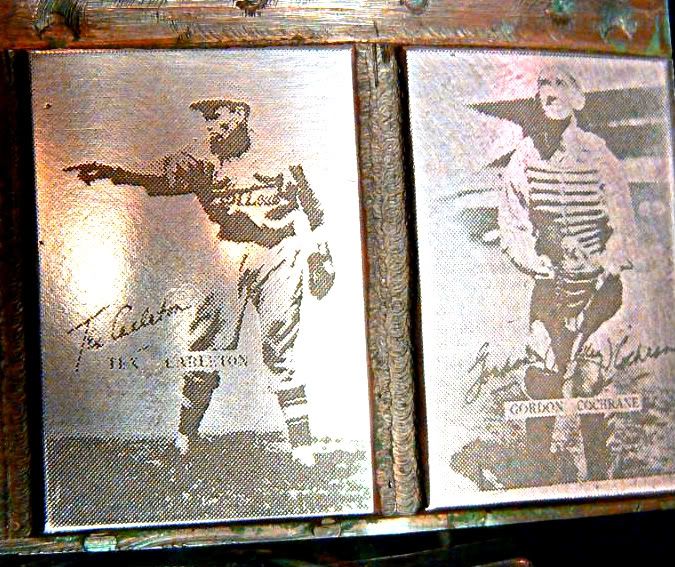 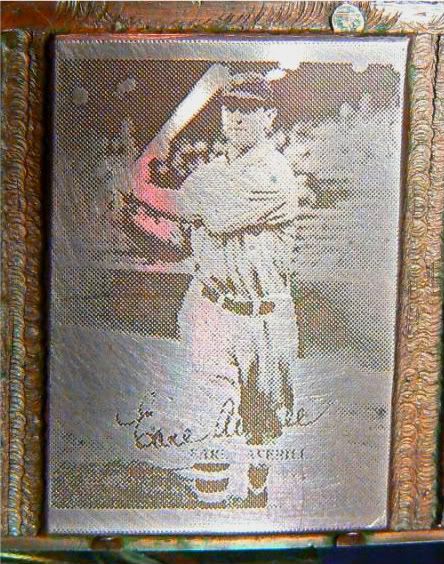 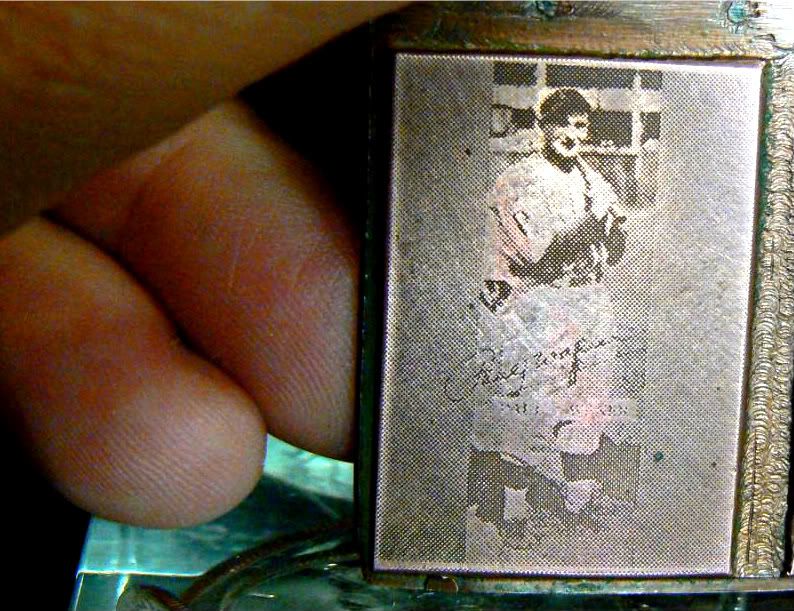  Please reply with your opinions. Thanks! 
__________________
"Variety is the Spice of Life!" |
|
#9
|
|||
|
|||
|
Here are the 1934 R310 Butterfinger of Paul Waner with the Paul Waner Printing plate image next to it. They are the same pic with the same right & left strips cut off, and the same autographs, but the printing plate has a capitol block lettered name below the signature "PAUL WANER" Plus the vast size differences, as the printing plate card is only 1 5/8" x 7/8"
  Somebody please solve the mystery of what card set this printing plate printed????
__________________
"Variety is the Spice of Life!" |
|
#10
|
||||
|
||||
|
Interesting.
I dont know of any cards that match the printing plate. |
|
#11
|
|||
|
|||
|
The screen (dot pattern) is really coarse, more like a newspaper picture.
Any chance they're from a newspaper or magazine ad for the premiums? Steve |
|
#12
|
|||
|
|||
|
Those pictures are so rough because I am giving you a microscopic view of very small cards, so you can see them in detail. They are on copper bright as new pennies so I have to angle them in the light just right to be able to see properly. They are NOT rough in any way. On the contrary ,they are very high quality. If I printed some cards with them, you would see how finely detailled they are. They have far greater detail actually than rough exhibit type cards or newspaper plates with huge dots. I am trying to get ONE question answered. "Which card set from the mid 1930s are they from??" Which set from the mid 30s used those pics with those autographs and those CAPITOL lettered names below them in that small size? Newspaper printing plates are like the example in this thread with the wood block attached, for them to move them around anywhere on the page, not a curved plate.
__________________
"Variety is the Spice of Life!" Last edited by olsport; 01-24-2010 at 08:19 PM. |
|
#13
|
||||
|
||||
|
Paul have you looked on Old Cardboard they show most of the old card sets and you can compare them with your plates. Click on Old Cardboard at the top of this page to get there. There are some of your poses on different sets but I didn't see a set with all the poses or size of yours. I was wondering if they could be a stamp set of some kind because of the small size. D.
|
|
#14
|
|||
|
|||
|
Maybe the plate was used to produce some promotional materials for the Butterfinger set.
|
|
#15
|
||||
|
||||
|
Those can't be printing plates in the sense that they were used to make the final image on paper/cardboard, because the image would be backward.
I know next to nothing about printing but maybe they were used in some sort of intermediate stage in the printing process. The only analogy I can think of is the coining process. A master hub is made (reverse image), which creates working hubs (actual image), which are used to create working dies (reverse image), which create coins (actual image). Maybe someone with printing knowledge can explain what they are. |
|
#16
|
||||
|
||||
|
Just a thought, transfers were printed in reverse.
|
|
#17
|
||||
|
||||
|
Quote:
Don, Your post is inaccurate. The image on an offset printing plate would appear 'normal' (not backward).... basically because the ink goes from the plate, onto a rubber blanket (becomes backward) and then onto the paper (is correct orientation again). Most printing in general, and I would guess most every baseball card printed in the modern era is/was printed on an offset printing press. It is the most common method of printing and has been for a very long time. The type of process you describe is flexography. Flexography would be where the plate is in direct contact with the paper (so the image would be backward on the plate). This is a more uncommon print process. I can't help much with regard to ID'ing the printing plate shown in this thread. sorry. But I did want to point out that most printing plates would have the image look correct on the plate (not backward).
__________________
Joe D. |
|
#18
|
|||
|
|||
|
A few comments.
It is a printing plate. There are metal proofs, which are rare themselves, and this isn't a metal proof. Cards back then were either photoengravings or lithographs. Both printing plates would be metal. I can't 100% tell from the pics what this are. It is true that with lithography they had/have a transfer process that would flip the image (via in between sheet of paper) during printing. Thus lithographic printing plates can have normal or backward image and text. The wooden backing was common on old commercial printing plates. I doubt it is from a newspaper, and it would seem unlikely from a magazine. Newspaper plates are almost always flat, and magazine plates I think are also usually flat. If it's a lithography printing plate, it is not for a periodical, including book. Periodicals back then weren't lithographs. I can't say it's for trading cards, but it is a neat item. Last edited by drc; 01-25-2010 at 11:22 AM. |
|
#19
|
|||
|
|||
|
You might be able to ID which cards they were by using the Beckett Alphabetical list book that gives each players name and what baseball cards they were on. I can`t find mine at the present time or I would look them up. Hope this may help you out. Thanks, Marc
|
|
#20
|
||||
|
||||
|
They are NOT from a known card set.
 Best response so far is that they might have been used to print images for a promo for the R310 set. But even then why would they add the bar with the printed players name??? |
|
#21
|
|||
|
|||
|
I just want to thank you all for putting your heads together and coming up with some very intelligent comments! Items like this are what makes the hobby so much fun for me. Buying something I like alot, even though I am not quite sure what it is, then the fun of trying to find out.
 
__________________
"Variety is the Spice of Life!" |
|
#22
|
||||
|
||||
|
Was hoping someone could help identify this print plate. This is a vintage solid alloy block (probably zinc) about 1 1/4" x 2 1/4" and weighs over a pound. It's a reverse image, so the batter is a lefty. I created a rough color rub and did a horizontal flip to get a close idea what it might look like.
My first thought was that it is a very traditional Ruth pose but he seems to be a bit slender...or maybe it is and I just did a lousy rub job. Seems to be some old red ink left over and what looks like pinstripes on the jersey, which can't be seen on the rub. Would be kinda' cool to see this on a card or ad. Any help would be appreciated.  Kevin Saucier . . . |
|
#23
|
||||
|
||||
|
Kevin - - most likely -
looks like a stamping die / not a printing plate. I would guess it was meant to be a generic player, and was stamped on every item in a production run (whether it was a book / card / folder / paper / leather/ who knows /etc.) If I had to pick a player.... he looks more like DiMaggio than Ruth to me.
__________________
Joe D. |
|
#24
|
||||
|
||||
|
looks like the size of four-on-one Exhibits which started in 1929....
meaning 4 of the imgaes would make up one card.... (although mainly portraits were used) maybe the cards they made never made it to the candy store... |
|
#25
|
||||
|
||||
|
Because of the curve to the plate this looks very much like a gravure printing black printing plate. They use that kind of printing for large runs. It bee around a long time. The line screen should be pretty detailed about 133 to 150 line screen. If it were for a news-paper the number of dots per inch (line screen) should be 115. You can use your 10X loop and just count them. Its not that hard. That should give you a much better Idea of what kind of substraight (paper) it was used to print on. And will narrow your search. Hope that helps
|
|
#26
|
|||
|
|||
|
Interesting thread.
The printer's block below was used--probably in a Wheaties' newspaper ad in 1935--to promote the Wheaties brand and the baseball cards found on the backs of their cereal boxes at the time. That was their first year to print athletes on their cereal boxes. The example card used on the block is that of Jack Armstrong. As we know, Armstrong was a fictitious all-American athlete used in a number of the company's promotions during the period. 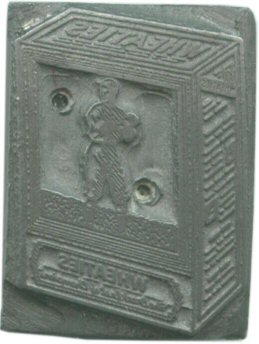 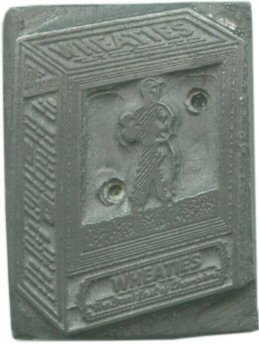 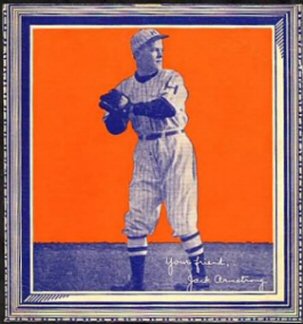 The three images are a) The printer's block when viewed directly, b) the block mirrored (to match the imprint that it makes, and c) a scan of the Jack Armstrong card from the back of a 1935 Wheaties box. Lyman |
 |
| Thread Tools | |
| Display Modes | |
|
|
 Similar Threads
Similar Threads
|
||||
| Thread | Thread Starter | Forum | Replies | Last Post |
| For Sale: Awesome 1886 Baseball dance invite card | GrayGhost | Baseball Memorabilia B/S/T | 1 | 11-10-2009 09:32 AM |
| LARGE List of Autographed Cards For Sale - 1940s through 2000s (All Sports) | canjond | Baseball Memorabilia B/S/T | 0 | 06-13-2009 06:54 PM |
| The Term Pre War Card | Archive | Net54baseball Vintage (WWII & Older) Baseball Cards & New Member Introductions | 2 | 04-22-2006 11:50 PM |
| What % of the value of your baseball card collection is 19th century cards? | Archive | Net54baseball Vintage (WWII & Older) Baseball Cards & New Member Introductions | 7 | 11-03-2005 03:38 PM |
| in love with pre war again!!!! | Archive | Net54baseball Vintage (WWII & Older) Baseball Cards & New Member Introductions | 6 | 04-14-2005 02:24 PM |